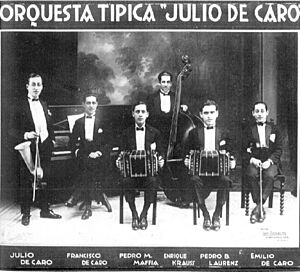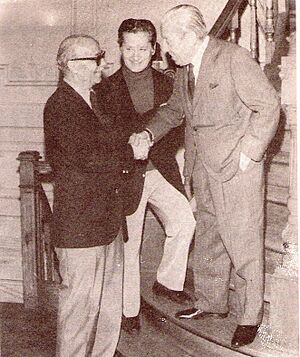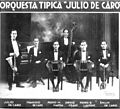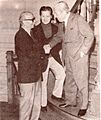Julio de Caro facts for kids
Julio de Caro (born December 11, 1899 – died March 11, 1980) was an Argentine composer, musician, and conductor. He became a very important figure in Tango music.
Contents
Life and Music
Early Life and Musical Beginnings
Julio de Caro grew up in San Telmo, a neighborhood in Buenos Aires. In 1913, his father opened a music school there. It quickly became a well-known place for music lessons and instruments. Julio and his brother, Francisco, both learned to play instruments. Julio started with piano, and Francisco with violin. But they wanted to switch, and their father eventually let them.
Julio loved music, especially tango. Against his father's wishes, he got a job as a second violinist in a theater in 1915. Even though his father was upset, Julio and Francisco kept going to popular tango shows. They were inspired by famous bandleaders like Eduardo Arolas and Roberto Firpo.
Joining the Tango World
In 1917, Julio de Caro was at a fancy place called the Palais de Glace. His friends encouraged him to play tango on stage. He borrowed a violin and played so well that everyone gave him a standing ovation! Eduardo Arolas, a famous bandleader, then asked Julio to join his orchestra.
Julio's father did not like popular music, so he tried to stop Julio. But Julio secretly joined Arolas's orchestra. There, he wrote his very first tango song, called Mon beguin.
New Orchestras and Tours
Julio's father eventually made him leave home when he was 18. His brother Francisco joined him, and they traveled with Arolas's orchestra. They became very successful in Argentina and nearby Uruguay.
In 1919, Julio and pianist José María Rizzuti left Arolas's group. They started their own quartet with Pedro Maffia (who played the bandoneon) and José Rosito (violin). They played to great applause at a café in Buenos Aires.
After this group split up in 1920, Julio and Rizzuti joined bandleader Osvaldo Fresedo. They even toured the United States together! In 1922, Julio moved to Montevideo, where he got married. He also joined Minotto Di Cicco's orchestra there. In 1923, he returned to Buenos Aires and played with Juan Carlos Cobián.
Radio Success and Innovations
When Cobián moved to New York City, the de Caro brothers needed a new band. At the end of 1923, they played at a New Year's Eve party and were a huge hit! This led to many jobs in popular cafés and on the radio.
The Julio de Caro Orchestra later signed a recording deal with RCA Victor. In April 1925, they even performed for Edward, the Prince of Wales. That same year, a U.S. jazz bandleader named Paul Whiteman showed Julio a special instrument called a Stroh violin. This violin had a horn at one end, which made its sound louder. It was perfect for radio performances because it could be heard clearly over the other instruments. Julio found it very useful.
Julio de Caro wrote many songs honoring important people who came to his shows. These included famous surgeon Enrique Finochietto and President Marcelo Torcuato de Alvear.
International Tours and Reconciliation
In 1931, Julio de Caro's orchestra was invited to tour France. They played at fancy venues and for important families like the Rothschilds. They also worked with Paramount Studios for a movie called Luces de Buenos Aires, which starred the famous singer Carlos Gardel.
The orchestra remained very popular in Argentina. In 1935, they played at the Colón Theatre, one of the country's most important opera houses. In 1936, they performed at the Teatro Opera. There, they presented a special show called "Evolution of the Tango." It showed how tango music had changed from 1870 until then. After one of these shows, Julio and Francisco's parents surprised them with a visit. This led to the family finally making up.
Later Years and Legacy
Julio de Caro's orchestra continued to be a favorite among tango fans for many years. They helped introduce new talents, like the singer Edmundo Rivero. However, as his audiences got smaller, Julio de Caro retired from his orchestra in 1954.
He remarried in 1959. In 1975, he returned to the recording studio. He worked with writer Ernesto Sábato and composer Ben Molar to create an album called Los 14 de Julio de Caro (Julio de Caro's 14).
The Argentine government honored Julio de Caro by declaring December 11 (his birthday) as "National Tango Day." On that day in 1977, he received a huge cheer at the Luna Park Arena in Buenos Aires. Everyone sang "Happy Birthday to You" to him.
Julio de Caro passed away in Mar del Plata on March 11, 1980, at the age of 80. He was buried in Chacarita Cemetery in Buenos Aires, next to his brother Francisco.
Images for kids
See also
- In Spanish: Julio de Caro para niños





